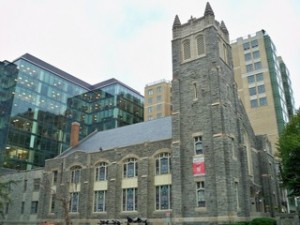
The Asbury United Methodist Church was founded in 1836.
One of the District’s oldest Black churches is challenging a proposed streetcar line that will cut into its property and significantly damage its century-old infrastructure.
Asbury United Methodist Church is located at the corner of 11th and K Streets., N.W., and has been there since its founding in 1836. However, one of the District Department of Transportation’s (DDOT) tentative streetcar plans includes building a Union Station-Georgetown streetcar. This has upset members of the predominantly Black church because it will cut 12 feet into its front lawn, destroying its marquee, retaining wall, sidewalk, and an 80-year-old Dutch Elm tree. Additionally, during construction the church’s stain-glass windows and bell tower could be damaged.
The other plan will leave the front lawn intact but eliminate parking on K Street. Floyd Robinson, a member of the church with a family lineage that goes back as far as the Civil War era, is not happy with any of the plans. “We’ve been at that spot for 178 years and now they want to do this,” Floyd Robinson, 85, said.
Asbury is the oldest Black church in the District that remains on its original site and it is listed on the D.C. Inventory of Historic Sites and on the National Register of Historic Places. The church played a role in the Underground Railroad and in the civil rights movement of the 1960s. Prominent Asburyans include the late civil rights activist and educator Mary McLeod Bethune, former District administrators Carol Thompson Cole and Robert Mallett, and Dr. Clive Callendar, world-renowned surgeon and advocate for African-American organ donations.
The plans for the 3.3 mile streetcar line start at 3rd Street., N.E. and will proceed west to 34th Street., N.W. It will primarily go through the K Street corridor, internationally known as the location of prominent legal and lobbying firms, trade associations and political organizations.
What really bothers church leaders is that the plans were formulated without their consultation.
“We do not believe that DDOT has given proper deference to Asbury’s designation as a significant historic site, and it has not engaged in the kind of robust consultation and citizen engagement process we should expect of public agencies when an action it seeks to undertake is so consequential,” said a letter co-authored by the Rev. Lanther Mills and Board of Trustees Chairman James Nero and sent to DDOT officials. “We respectfully request DDOT to reconsider its proposal as designed to eliminate its deleterious impacts on one of the oldest and most historic African-American churches in the city of Washington.”
Forty church members attended a public hearing on the matter on Oct. 2 at the Carnegie Library in downtown. Three large tables had maps of the streetcar line area and there were posters on the project around the room. DDOT officials also were on hand to answer questions.
Tawanna Jackson, a church member, viewed the displays and said she supports progress but is wary of the city’s plans. “Streetcars are so large,” she said, voicing concern about church damage and parking. “Church members will have to park somewhere else and that will affect other cars and public transit.”
Lezlie Rupert, the streetcar line’s project manager, talked with church members at the hearing and said that she is listening. “This process today is not the end of the story,” Rupert said. “I am happy to see the church members here and they are speaking up. We will work with the church and do what is in the best interest of the church and the city.”
The next public hearing on the streetcar line is in November and the public engagement process will continue until late 2015, when a final decision on the project will be made by the DDOT. Mills said church members will not sit idly by and let the church be negatively impacted by the streetcar line.
“We will connect with our council member, Jack Evans, and Mayor Vincent Gray and Muriel Bowser and David Catania,” the minister said. “We have not made a decision on whether we will take to the streets on this. Not yet.”

